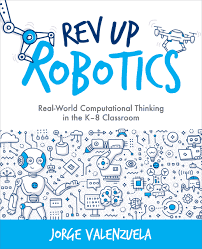Rev Up Robotics Aims for Computer Science Accessibility & Application

There is no doubt that computer science and computational thinking are part of a skill set that many educators and futurists are identifying as key for our students in terms of their long-term academic and economic success—especially in a truly globalized environment. And although there are many potential entry points and areas of study (coding, robotics, engineering, STEM), it is often challenging for many classroom teachers to know where to start and how to get their students on board in a successful way. Enter Jorge Valenzuela (@JorgeDoesPBL) and his new ISTE book Rev Up Robotics.
This latest book from ISTE is ideally intended to be a hands-on, step-by-step guide for any teacher who wants to engage their students and teach real world skills through robotics. It is designed to help K-8 teachers in any content area get started in these skills, level-up practice, and engage their students at higher levels.

ISTE Editor Emily Reed said that this book is the latest in a series focused on tackling the world of computer science education. The first title in this series was Heidi Williams’ No Fear Coding which advocated for the integration of coding and computer science skills across subject matter areas, especially with younger children. The second was Josh Caldwell’s Creative Coding which focused on projects and strategies for integrating computer science and concepts at the middle school level.
As the editors at ISTE looked for the next book in the series, Reed said they came across Valenzuela’s work with computational thinking and project-based learning. Reed acknowledged that they were impressed with his ideas, as well as his knowledge of the ISTE Standards.
“We approached him about writing a book on robotics as we saw this as a logical next step in the series,” said Reed.
Jorge Valenzuela—longtime and highly acclaimed teacher and professional learning facilitator in the areas of computer science, engineering and project-based learning—believed the editors at ISTE were responding to an increased public interest that was requesting a how-to robotics book that provides specific but actionable advice for seamless integration across the curriculum.

Valenzuela said he started receiving regular and frequent requests from teachers for assistance with understanding components of the K-12 Computer Science Framework, the The Computer Science Teachers Association Standards, and ISTE Standards. More specifically, many of these educators are wanting to level up their skills for engaging students in robotics by having them build and program robots.
Both Reed and Valenzuela indicated that this book is a conscious attempt to create an evergreen of resources for the core content areas (and easily adapted in the elective areas) in the context of educational robotics and in tandem with computational thinking.
Preparing learners for a future with technology is at the core of ISTE’s mission. “We recognize that students will need to learn and practice new skills such as coding and computational thinking in order to be successful,” said Reed.
Valenzuela believes that Rev Up Robotics could be the right book for the right time in terms of the current movement across the country to include both computational thinking and computer science in education reform. With states adopting various computer science standards and expectations, there is an ever-growing need to develop educational resources and provide training that helps both educators and schools make this transition in classrooms, according to Valenzuela.
“Jobs in robotics and computation are a present reality. To fully develop and maximize our country’s computer science talent pool, our schools need to address robotics and other computer science learning systematically in the K-12 system,” said Valenzuela.
Although many in and outside of the education field have heard of things like robotics, computer science, coding, computational thinking, and more recently artificial intelligence, Valenzuela believes this book is different.
“This is geared towards any educator interested to learn more about the topic(s) and also how to begin integrating it into their existing curriculum,” said Valenzuela. “It takes teachers beyond scripted curriculum with deeper learning while also breaking it down into digestible and practical sections designed for easy implementation,” he said.
This book is not designed to have all students become computer scientists or enroll in undergraduate majors in computer science. But since every field and industry is greatly impacted by computers, Valenzuela believes all students need to be exposed to computer science throughout their K-12 experience.
“It has become as essential to learning reading, writing, and mathematics because it provides them the know-how for how the technology they use daily works in the world and also for career preparation,” said Valenzuela.
The book features three sections that focus on advice, pro tips, and resources. Computational thinking is weaved into every lesson in the book and the aim here is to allow teachers to remain content area teachers, while providing them the know-how for teaching relevant problem-solving skills needed for both the classroom and the world of work. One key feature of the book is that it meets all readers where they are and provides them actionable steps that they can replicate while still teaching the academic standards in the CCSS, NGSS, and NCSS.
After Valenzuela defines and helps readers understand what robotics is and what it looks like in a general instructional sense, he provides lots of resources and honors work that has already been done. He eliminates all of the guesswork about where this could reside in one’s curriculum. He connects all of this to essential standards in ELA, Math, Science, and Social Science. Additionally, both the CSTA and ISTE standards are also addressed in alignment with highlighted lessons.
Ultimately, Valenzuela discusses teaching all of this through deeper learning sciences and project-based approaches. He includes examples of how he has incorporated this into his own classes, courses, and workshops, while also providing pro tips on starting after school clubs and competitive robotics.
With the aim of really connecting with core academic and elective teachers, versus computer science or STEM teachers, Valenzuela said the book features relevant standards and learning goals for each content area connected to the context of robotics, computational thinking, and computer science.
“The book will not replace an entire curriculum but will give teachers enough substance to cover these topics confidently within the context of their content area,” said Valenzuela. “Additionally, the lessons are also easily adaptable.”
In the end, Valenzuela says that this book is not designed to have all teachers develop intricate lessons featuring robotics and computer science, but rather develop an understanding of applying computational thinking for problem solving.
“My intention is that all teachers develop a better understanding of the large technological change that automation has brought to the world and how this is impacting jobs and careers for all students,” said Valenzuela. “I am hoping my book is viewed as a ‘how-to guide’ going beyond what we need to do.”
Rev Up Robotics is available digitally January 21st and in print January 28th. It will be featured at the ISTE conference in Anaheim at the end of June, where Valenzuela will present his work from the book. ISTE plans to host author webinars and podcast appearances, as well as offer a Jump Start Guide companion to the book.
Both Valenzuela and ISTE are hoping that this book is seen as a valuable professional resource for districts, schools, and enthused educators everywhere for leveling up their teaching practice with robotics.
For more, see:
- 2019 Coding and Computer Science Resources
- The Top Five Unexpected Benefits of Robotics in the Classroom
- The Importance of Understanding Technology, Coding and Computational Thinking
Stay in-the-know with innovations in learning by signing up for the weekly Smart Update.








0 Comments
Leave a Comment
Your email address will not be published. All fields are required.